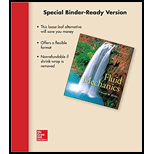
Concept explainers
(a)
To select:
The pump that runs at the given speed performing the task with efficiency being maximum.
Answer to Problem 11.4CP
The pump that runs at the given speed performing the task with efficiency being maximum is determined below.
Explanation of Solution
Given Information:
The given figure,
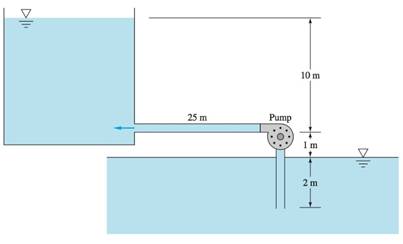
The system delivers 20-degree Celsius water from the sea level reservoir to another iron pipe with diameter 38 cm.
Minor loss before pump entrance
Minor loss after pump entrance
Concept Used:
Velocity of the flow:
Calculation:
According to the figure:
Reynold’s number:
Density
Dynamic Viscosity
Diameter=380mm
Volume=12.24m/s
Substituting the values:
The flow is turbulent.
Friction factor is given as:
Head loss using the friction factor is calculated.
Using equation (1)
Frictional heal loss is calculated using flow rates having different values:
| Q(gal/min) | 4000 | 8000 | 12000 | 16000 | 20000 | 22000 | 24000 |
| |
44 | 66 | 103 | 156 | 223 | 262 | 305 |
From the table and the reference figure at the flow rate of 20,000 gal/min, 88% efficiency. Hence the pump is given as 38 in.
Conclusion:
Thus, the pump that runs at the given speed performing the task with efficiency being maximum is determined.
(b)
To calculate:
The flow rate.
Answer to Problem 11.4CP
The flow rate is given as 20,000 gal/min
Explanation of Solution
Given Information:
The given figure:
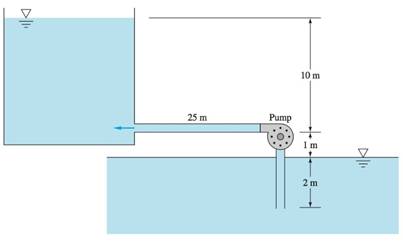
The system delivers 20-degree Celsius water from the sea level reservoir to another iron pipe with diameter 38 cm.
Minor loss before pump entrance
Minor loss after pump entrance
Concept Used:
Velocity of the flow:
Calculation:
Reynold’s number
Density
Dynamic Viscosity
Diameter=380mm
Volume=12.24m/s
Substituting the values:
The flow is turbulent.
Friction factor is given as:
Head loss using the friction factor is calculated:
Using equation (1)
Frictional heal loss is calculated using flow rates having different values:
| Q(gal/min) | 4000 | 8000 | 12000 | 16000 | 20000 | 22000 | 24000 |
| |
44 | 66 | 103 | 156 | 223 | 262 | 305 |
Conclusion:
Thus, the flow rate is determined.
(c)
Brake horse power.
Answer to Problem 11.4CP
Brake horse power=1250hp
Explanation of Solution
Given Information:
The given figure,
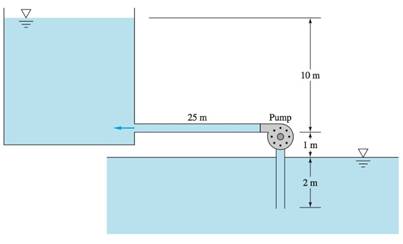
The system delivers 20-degree Celsius water from the sea level reservoir to another iron pipe with diameter 38 cm.
Minor loss before pump entrance
Minor loss after pump entrance
Concept Used:
Calculation:
Substituting we have:
Conclusion:
Thus, the brake horse power is calculated.
(d)
The given pump is safe from cavitation.
Answer to Problem 11.4CP
The pump replacement is needed as the pump will cavitate.
Explanation of Solution
Given Information:
The given figure:
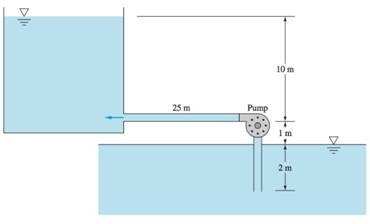
The system delivers 20-degree Celsius water from the sea level reservoir to another iron pipe with diameter 38 cm.
Minor loss before pump entrance
Minor loss after pump entrance
Concept Used:
Calculation:
Substituting we have:
For the flow rate Q=20000gal/min, the NPSH=16m(-0.36m).
So, the pump cavitates.
Conclusion:
Thus, the given pump is safe from cavitation is determined.
Want to see more full solutions like this?
Chapter 11 Solutions
Loose Leaf For Fluid Mechanics
 Elements Of ElectromagneticsMechanical EngineeringISBN:9780190698614Author:Sadiku, Matthew N. O.Publisher:Oxford University Press
Elements Of ElectromagneticsMechanical EngineeringISBN:9780190698614Author:Sadiku, Matthew N. O.Publisher:Oxford University Press Mechanics of Materials (10th Edition)Mechanical EngineeringISBN:9780134319650Author:Russell C. HibbelerPublisher:PEARSON
Mechanics of Materials (10th Edition)Mechanical EngineeringISBN:9780134319650Author:Russell C. HibbelerPublisher:PEARSON Thermodynamics: An Engineering ApproachMechanical EngineeringISBN:9781259822674Author:Yunus A. Cengel Dr., Michael A. BolesPublisher:McGraw-Hill Education
Thermodynamics: An Engineering ApproachMechanical EngineeringISBN:9781259822674Author:Yunus A. Cengel Dr., Michael A. BolesPublisher:McGraw-Hill Education Control Systems EngineeringMechanical EngineeringISBN:9781118170519Author:Norman S. NisePublisher:WILEY
Control Systems EngineeringMechanical EngineeringISBN:9781118170519Author:Norman S. NisePublisher:WILEY Mechanics of Materials (MindTap Course List)Mechanical EngineeringISBN:9781337093347Author:Barry J. Goodno, James M. GerePublisher:Cengage Learning
Mechanics of Materials (MindTap Course List)Mechanical EngineeringISBN:9781337093347Author:Barry J. Goodno, James M. GerePublisher:Cengage Learning Engineering Mechanics: StaticsMechanical EngineeringISBN:9781118807330Author:James L. Meriam, L. G. Kraige, J. N. BoltonPublisher:WILEY
Engineering Mechanics: StaticsMechanical EngineeringISBN:9781118807330Author:James L. Meriam, L. G. Kraige, J. N. BoltonPublisher:WILEY





